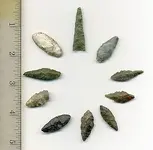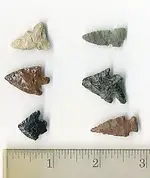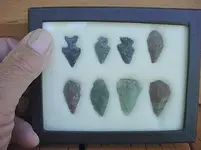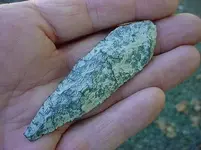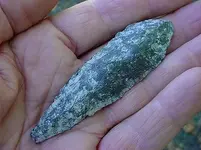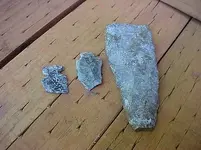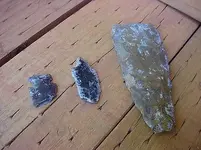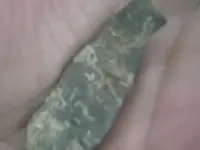BosnMate
Gold Member
- Joined
- Sep 10, 2010
- Messages
- 6,916
- Reaction score
- 8,441
- Golden Thread
- 0
- Detector(s) used
- Whites MXT, Whites DFX, Whites 6000 Di Pro
- Primary Interest:
- Other
On my last post, my wife and I were on 9 acres of Indian camp in Atascadero, California. We sold that place and moved several times, ending up in northern California, on the Eel River to be exact. By then, I was off and on self employed, and we had about 30 head of cattle and our horses on rented pasture, that, by the way, didn’t have any Indian history that I could find. However, as luck would have it, one winter I was hired by a neighbor to ride through his cows a couple of times a week. For a couple of reasons, this was truly luck for me; for one, I needed the money, and two, there was an ancient Indian camp on his place. I would ride the horse up the hill on a dirt ranch road to where the cattle were being pastured in the breaks of the Eel river. Up on the side of a very steep hill, with the road cut right through the middle of it, was a clearing and a spring. On a wet day in February, I noticed chips and flakes on the road, and then a point, and another, and from that day forward, every time I crossed that clearing after a rain, points were in the road shinning up at me, and of course I picked them up.
[attach 1]
Note that these points are all small, what I would call in those days “bird points.” At the same time I’d wonder how they were attached to an arrow. Now I’m wondering if they ever were arrowheads. These would be Pomo points/tools, and these Indians were/are very famous for their baskets. I wonder if these type of biface tools were used in some way as a basket making tool?
[attach 2]
Now these are what I’d still call bird points, they are small, and it’s interesting to note that three points are obsidian, two black and one red. This volcanic glass had to have been traded in from quite a long way, and they came from the same place as the ones in the first frame.
[attach 3]
These are also Pomo points, but from a different location, and two of them have a very interesting story. At that time there were lots of feral pigs, “wild hogs” in that area. Don’t for a second think they are in competition with Arkansas wild razor back hogs. But if a bunch of pigs are inbred for just a few generations, then they grow tusks and come close to being a razor back. The locals used to joke about those pigs being “California corn fed hogs,” then laugh and say, “Acorns.” Anyhow, one wintery day we had about an inch of snow on the ground, and that snow pretty well covered everything. I had permission to hunt pigs on a friends ranch. My X wife was with me, and we were driving down the ranch road, looking for tracks in the snow. We hadn’t seen a thing, no pigs, no tracks or rooting. At the bottom of the hill that we were driving down, the road crossed a small creek, and on the other side was a closed gate. I got out and opened the gate. Now folks, you can’t make this stuff up, and I wouldn’t believe what I’m about to tell you if it hadn’t happened to me. In the road, there were a few small (perhaps 3 or 4 inches across) round spots where the snow had melted down to dirt. Right in the middle of one of those was a small obsidian arrowhead. Guess what, I checked out another of those spots, and it was a repeat, and those two points are in the center of the top row of the above frame, and left to right, the 3 points are black obsidian. I went back after the snow melted and found a few more points. I never did even see a pig, let alone shoot one.
[attach 4]
Now we are going to change pace a bit, because that’s all I found in that area. This above pictured artifact was found by me in the foothills of the Sierra Nevada, in the southern part of the Gold Country, near Raymond, California. The biface in that picture is obsidian that is totally covered with something that won’t wash off. Now folks, please don’t chew me out, I wasn’t always as old, pretty and smart as I am now, in fact I was at times a rather dumb kid. I didn’t want that stuff on the point, so I tried to remove it with a power wire brush. It didn’t work, and I gave up, as evidenced by the photo below.
[attach5]
Later I was told by a person that should know, that the stuff on the point was because it was in the body of a critter that decayed away, and it’s some kind of a stain. So since then, I’ve found three more, which I’ll share with you.
[attach 6]
The photo shows the points on one side. There is a broken black obsidian arrowhead, and in the center is more of an obsidian flake than a worked a tool, but I think that a lot of times obsidian is so sharp that they would knock a spall off a rock and use it as it, so it might have been used as a knife and ended up inside a critter that decayed away. The larger item is either chert or jasper. The photo below is the opposite side of the same points.
[attach 7]
Does anyone know anything about the stain being from being in decaying flesh? Keep in mind that these points were found hundreds of miles apart and years in between the finds.
That’s all for this post. The next post will be odds and ends, followed with another showing Nevada points, and the last one in this series will be some points found here in Oregon.
[attach 1]
Note that these points are all small, what I would call in those days “bird points.” At the same time I’d wonder how they were attached to an arrow. Now I’m wondering if they ever were arrowheads. These would be Pomo points/tools, and these Indians were/are very famous for their baskets. I wonder if these type of biface tools were used in some way as a basket making tool?
[attach 2]
Now these are what I’d still call bird points, they are small, and it’s interesting to note that three points are obsidian, two black and one red. This volcanic glass had to have been traded in from quite a long way, and they came from the same place as the ones in the first frame.
[attach 3]
These are also Pomo points, but from a different location, and two of them have a very interesting story. At that time there were lots of feral pigs, “wild hogs” in that area. Don’t for a second think they are in competition with Arkansas wild razor back hogs. But if a bunch of pigs are inbred for just a few generations, then they grow tusks and come close to being a razor back. The locals used to joke about those pigs being “California corn fed hogs,” then laugh and say, “Acorns.” Anyhow, one wintery day we had about an inch of snow on the ground, and that snow pretty well covered everything. I had permission to hunt pigs on a friends ranch. My X wife was with me, and we were driving down the ranch road, looking for tracks in the snow. We hadn’t seen a thing, no pigs, no tracks or rooting. At the bottom of the hill that we were driving down, the road crossed a small creek, and on the other side was a closed gate. I got out and opened the gate. Now folks, you can’t make this stuff up, and I wouldn’t believe what I’m about to tell you if it hadn’t happened to me. In the road, there were a few small (perhaps 3 or 4 inches across) round spots where the snow had melted down to dirt. Right in the middle of one of those was a small obsidian arrowhead. Guess what, I checked out another of those spots, and it was a repeat, and those two points are in the center of the top row of the above frame, and left to right, the 3 points are black obsidian. I went back after the snow melted and found a few more points. I never did even see a pig, let alone shoot one.
[attach 4]
Now we are going to change pace a bit, because that’s all I found in that area. This above pictured artifact was found by me in the foothills of the Sierra Nevada, in the southern part of the Gold Country, near Raymond, California. The biface in that picture is obsidian that is totally covered with something that won’t wash off. Now folks, please don’t chew me out, I wasn’t always as old, pretty and smart as I am now, in fact I was at times a rather dumb kid. I didn’t want that stuff on the point, so I tried to remove it with a power wire brush. It didn’t work, and I gave up, as evidenced by the photo below.
[attach5]
Later I was told by a person that should know, that the stuff on the point was because it was in the body of a critter that decayed away, and it’s some kind of a stain. So since then, I’ve found three more, which I’ll share with you.
[attach 6]
The photo shows the points on one side. There is a broken black obsidian arrowhead, and in the center is more of an obsidian flake than a worked a tool, but I think that a lot of times obsidian is so sharp that they would knock a spall off a rock and use it as it, so it might have been used as a knife and ended up inside a critter that decayed away. The larger item is either chert or jasper. The photo below is the opposite side of the same points.
[attach 7]
Does anyone know anything about the stain being from being in decaying flesh? Keep in mind that these points were found hundreds of miles apart and years in between the finds.
That’s all for this post. The next post will be odds and ends, followed with another showing Nevada points, and the last one in this series will be some points found here in Oregon.
Amazon Forum Fav 👍
Attachments
Upvote
0



